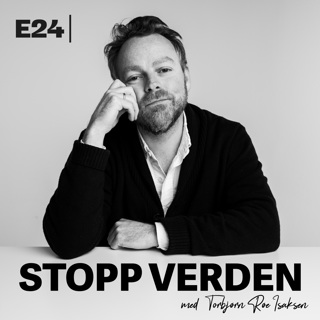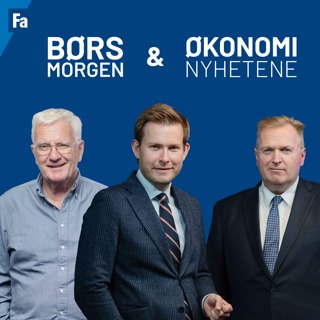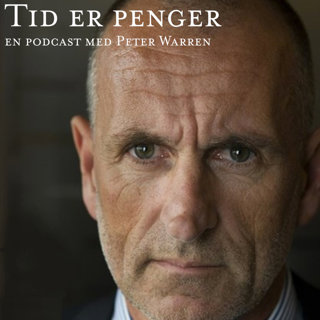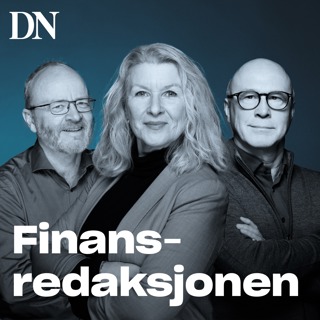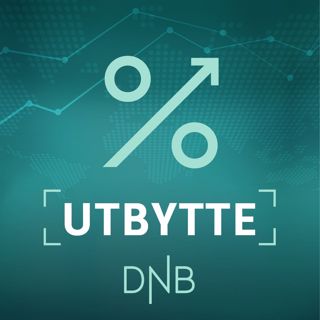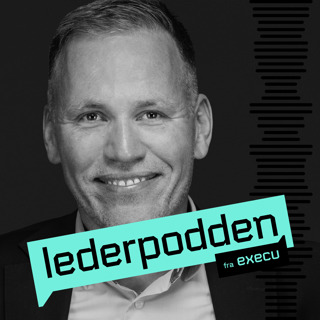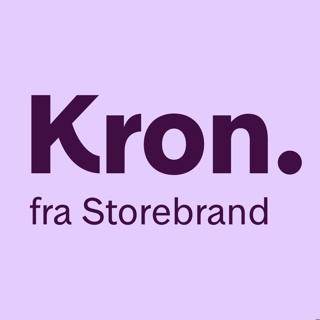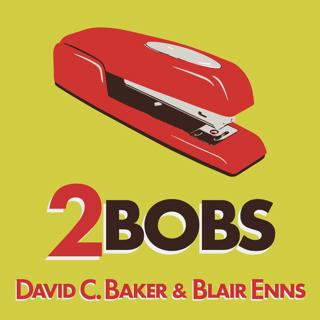
Greatness Requires Discomfort
David and Blair each share their own perspectives on how chasing comfort has kept them and their clients making the right decisions in both management and sales situations. LINKS 2Bobs Episode 2: Say What You Think The Challenger Sale: Taking Control of the Customer Conversation by Matthew Dixon
22 Mai 201928min

Selling to Clients With In-house Resources
Blair wants creative firms to quit viewing in-house resources as the enemy and demonstrates how the arrangements between the two can be mutually beneficial. LINKS 2Bobs Episode 2: Say What You Think 2Bobs Episode 57: There are NOT Seven Reasons Why Clients Hire You
8 Mai 201929min

Things Principals Should Do More Of
David and Blair each share a list of things that they wish agency principals would do more of to take their firms to the next level of success. Links "The Problem of Standards" by David Maister 2001
24 Apr 201922min

There Are NOT Seven Reasons Why Clients Hire You
Blair and David work on clarifying things by coming up with only six reasons why businesses hire creative firms.
10 Apr 201930min

Where Do Ideas Come From?
Blair and David share the places they find good ideas that they turn into content, the best of which end up being incorporated into their services. Read the transcript ➝
27 Mar 201932min

It's a Small World After All
David finds Blair's thoughts fascinating on how far agencies should service or pursue clients geographically, and whether or not the location of a firm should be a factor.
13 Mar 201929min

Why Account People Should Close New Business
David gives Blair four practical reasons for sales people to hand off new business to the account person before the deal is closed instead of after.
27 Feb 201923min

A Beginner's Guide to Negotiating
David gets into Blair's head to get his 10 basic negotiating tips that he has worked with clients on over the years. LINKS “10 Negotiating Tips” (with 5 bonus tips) “Selling in One Lesson,” 2Bobs episode 49 Buying Less for Less: How to avoid the Marketing Procurement dilemma, by Gerry Preece Negotiating with Backbone: Eight Sales Strategies to Defend Your Price and Value, by Reed K. Holden TRANSCRIPT DAVID C. BAKER: Blair, today we are going to talk about 10 really interesting ways you can get your spouse to go ... Wait, I haven't, quit laughing. I haven't - BLAIR ENNS: I'm out. DAVID: How to get your spouse to go to the place for dinner that you want to go to. BLAIR: Okay. DAVID: How's that? BLAIR: Sure. What kind of trouble could we possibly get into? DAVID: Yeah, that would be a really stupid pod ... No. What we're talking about are some negotiating tips that you've thought about over many years. You've polled, you've tested, you've researched. You've worked with clients on. You've consolidated them into this one place. We may get to some bonus tips. I don't know if we'll have the time, but we definitely want to talk about the 10 basic tips around negotiating. Can you get me inside your head for a minute before I start pulling these out from you one by one? BLAIR: Well it's pretty crowded in there. What is it that you wanted access to? I gave you my password to everything the other day. What else do you want? DAVID: Is this going to be this difficult today? Are we going to do that? Or are we going to be cooperative? BLAIR: I'm feeling a little punchy. DAVID: Yeah, I see. I see you are. BLAIR: I'm in another hotel room. This is day 31 of a 36 day road trip. I tweeted today, "Okay. I've answered the question, how much travel is too much?". DAVID: Yeah. BLAIR: Getting into my head, I think these tips, I considered it kind of a beginner's guide to negotiating. I don't consider myself to be an expert on negotiating. But you can't advise people on the subject of selling and pricing without knowing something about negotiating, so a while ago I took a bunch of the best practices that I've encountered on the subject of negotiating, and kind of put it into one place. That's I think what we're going to talk about today. I'll call it a beginner's guide to negotiating, and we're referencing to these 10 tips that I've published previously. DAVID: Hopefully it will be more than a beginner's guide. But we'll just set people's expectations low. BLAIR: Yeah, right. DAVID: Then we'll exceed them. BLAIR: That's exactly what I was doing. DAVID: There are 10 in here. But there are two of them that we've actually had the chance to talk about in previous episodes. I will reference all 10 of them. But then with two of them I'm going to point people to a previous episode if they want to really bone up on all that stuff. DAVID: The first one is, avoid over-investing. This is one that we have talked about. It was in a recent episode. It was called Selling In One Lesson. The idea is that the more somebody wants it, the more at a disadvantage they are, right? Just summarize that for us and then we'll move on to the number two one. Over-investing is the first one. BLAIR: Yeah, so you can, a good metaphor for negotiating would be a poker game where there's times when you're bluffing, when you're playing certain hands. But in particular the idea of bluffing. Or calling somebody else's bluff. You can apply some of the tips that we'll talk about here. If it's very clear to the client that you want this so bad, and it's clear to the client not just from what you say, but from all of the free work that you have done, all of the costs that you've incurred. If you are clearly over-invested in the sale then you do not have much of a bargaining position. Because you are demonstrating through your behavior that you want it more than the client does. Therefor the client is the one with the power in the relationship. BLAIR: It's a big broad rule. Avoid over-investing in the sale. As you pointed out, we covered this in detail in the podcast, Selling In One Lesson. DAVID: Okay. Even if you do desperately need it, don't act like it. BLAIR: Right. DAVID: Second, and here we want to start diving in in more detail. The second principle for negotiating is, ask the question, "Have we already won?". As I read that, I wasn't sure exactly what you meant. That led me to dive a little bit deeper into this, and I found it really interesting. "Have we already won?". Are you really asking that specific question? Or is it more just framing the negotiating in your head? BLAIR: This is a negotiating point specific to the topic of negotiating with procurement. This comes up a lot, I wrote about this in my book, Pricing Creativity: A Guide To Profit Beyond the Billable Hour. In the last month in the various places I've been, and the talks that I've done, and the training I've done, procurement has come up a lot. Where I'll talk about a principle and somebody says, "Yeah, but you don't understand. That doesn't work with procurement". BLAIR: The role of procurement, and I learned the most from this listening to a talk by a guy named Tom Kinnaird. Tom was head of procurement at WPP. Gerry Preece is another great resource on negotiating with procurement people. Gerry is an ex P&G global design procurement person who has a consulting practice, and he's written a great book on dealing with procurement. It's called Buying Less For Less. I think the subtitle is The Marketing Procurement Problem. BLAIR: When I was listening to Tom Kinnaird, who was former head of procurement at WPP and is now a consultant, he was giving away at a conference in London I was also speaking at, he was giving away some insider procurement tips. One of the tips he gave away was, you need to know that procurement often lies. When procurement shows up at the end of a negotiation, when you feel like you are the ordained firm, you've either won the business or you're in the pole position, and then procurement shows up to negotiate the final deal. In that situation, almost greater than nine out of 10 times, you have won. You've already won, and the concessions that procurement is demanding that you make, it's not mandatory that you make them. BLAIR: Procurement's going to communicate to you that, in order for you to win the business, that it's still a competitive situation, they're still considering other firms. In order for you to win the business you have to cut price. The general rule of thumb is, if procurement shows up late and starts using that language on you, they're lying. I talk about this in my next article. I'm actually quite heated about it in the next article. So far I'm only at the unedited version of it. DAVID: Still very angry. BLAIR: Yeah. It will be published by the time this podcast goes to air. Hopefully it's a little bit more measured. But in it I make the point that procurement is the only profession in the world that I know of where they're taught that it's okay to lie. It's okay to outright lie in the course of everyday business. When they show up late and say, "You need to sharpen your pencil. We've got three bids. You're the highest bidder. You need to get your price to X or you're not getting the business", they're almost always lying. BLAIR: Now when procurement shows up at the beginning and they navigate the entire purchase process, you have another problem. They're not lying. It's an even bigger problem. They're seeing what it is that they're buying as a commodity, so you have to ask yourself, should you be even participating in a process where the client clearly does not value what you do, and it's seen as an expense to be minimized rather than an investment to be made? But the lesson is, so the tip is, ask the question, "Have you already won?". BLAIR: When you're in a situation where it feels like you've won, and then procurement comes in and says, "You haven't won yet. You've got to get past us. You have to give us all of these concessions", don't believe them. In fact I would go further and say, "We have this idea that we've got to throw procurement a bone in a situation like this. We'll give them this one win and then they'll go away". That's not how they work. They're trained to keep asking until you say no, so you want to start with no. BLAIR: We could go deeper into that. We could do a whole podcast on negotiating with procurement. But that's the tip. You ask yourself before you start giving concessions away, ask yourself, "Wait a minute. Have I already won here? Is it really necessary for me to make these concessions?". Because in a lot of situations you have already won, and it is not in your interest to make any concessions whatsoever. DAVID: The main clue is found in when procurement comes. At the beginning or the end. BLAIR: Yes. DAVID: That's the second one, okay. The third tip here takes this further, and it's around the idea that procurement lies regularly. Not just about this one thing that we're talking about that relates to how to decipher the timing and whether you've actually won. BLAIR: Yeah, so it is a recurring theme here. You might think, I always say, "Attack ideas. Don't attack people and organizations". But I always make an exception for procurement. Reid Holden, who's written a couple of great books on pricing and also on negotiating, and he infiltrated the world of procurement. He has this great line, and I repeat it often. "80 percent of procurement people give the other 20 percent a bad name". DAVID: As opposed to 20-80, yeah. You're flipping that around, right? BLAIR: Yeah. In the story I'm writing, I'm writing two different examples of two different agencies pitching two different pieces of business and then having to deal with procurement. One hold their ground and the other one doesn't hold their ground. The example where the agency holds their ground, they're told in the beginning, "The account is a $500,000 a year retainer", and so they do a little pilot project for free. They prove validation. Then they're handed off to procurement and procurement says, "The fees are not $500,000. They're $300,000. Take it or leave it". The firm walked away, and in the end the client came back and said, "Oh, no no. We want you to work with us. You can have the original $500,000". BLAIR: As I was talking to the agency president who was telling me this story, I said to him, "If I were you in that situation. If I'd heard that from the procurement person, I would want to get the client and the procurement person in the room together. I would want to look them both in the eyes and say, 'I want to know which one of you lied to me. You said it was $500,000 in fees. You said it's not $500,000, it's $300,000. One of you lied. Which one was it?'". BLAIR: We know who the liar is. The liar is always procurement, right? Because they're taught that it's okay to lie. But I just imagine, and I'm ranting in this article, and you can feel me getting emotional now. Because I can't believe that we continue to give this egregious behavior a free pass. We need to call out irresponsible practices and outright lies when we hear them from our clients and our clients' procurement department. I hope I've addressed the issue of three procurement lies. I feel like we should probably get off the subject of procurement. DAVID: Well I turned the recorder off a long time ago, and what people are going to hear instead of you ranting is me providing a very reasonable response to all of these things. BLAIR: Instead of my therapy while I lie on your couch. I'm going to a marketing procurement conference in London. I think it's in June. I'm really looking forward to being in the room with these people, and having an open conversation about what I think of their business practices. DAVID: The third point is, beware of procurement lies. Let me just read some of these and then we'll go to the next point. "It's down to you and one other". That's one lie. Another one is, "Yours is the highest bid". Another is, "You have to cut your price to remain in contention", or all these other things that you might hear. BLAIR: Or, "Take it or leave it. There's no negotiating. There's no middle ground. Here's my offer. Take it or leave it". That's another one. DAVID: Right, yeah. Then a concession, you say, is an invitation to ask for more. All right. Let's get you back down to happy land, and we'll move off of procurement. BLAIR: Well we're still going to talk about procurement a little bit here in the next one. Go ahead. DAVID: The fourth point is, outwait the waiter. Outwait the waiter is the fourth point. Talk about that. BLAIR: Yeah. I forget where I heard this idea from first, because I really would like to attribute to the various sources that I've pulled all of these things from. It might be Chris Voss who wrote, "Never split the difference. Negotiate like your life depends on it". Or it might be Jim Camp. Or it might be Tom Kinnaird. I don't remember who. But the idea is, when you're in the final negotiations with people, and again it's almost always procurement. Because it's procurement who's trained in negotiating. That's another point. We really need to be trained in negotiating to counteract those on the client side who are trained in negotiating. BLAIR: One of the tactics that they do is, after you've won, or you think you've won, they slow everything down. Procurement will say, "I'll get back to you in this time period", and then they'll take longer. You'll reach out to them and leave a message, and they'll just kind of stretch things out to make you sweat and to make you more nervous. That's the way they can extract more concessions from you. BLAIR: Again, if you think back to the formula that we talked about in Selling In One Lesson, P equals DB over D. Your power in the sale is a function of your desirability, is your desirability greater than your own desire? Because if it's not, if you're communicating that your desire for the client and the engagement is higher than the client's desire, then you have the least power in the relationship. The tactic when procurement is trying to slow things down to make you sweat is, you slow things down even more. If they take 24 hours to get back to you, you take 48 hours. You communicate to them that, "Yeah, that's fine. We're in no rush. I mean, if this is going to happen it's going to happen. If it isn't, that's fine too". BLAIR: It's almost a game of, and there are times when negotiating really is a game and it really should be fun. It's never fun if you're over-invested in the sale, right? DAVID: Yeah, right. BLAIR: But it should be fun, and you should play this game. Instead of being anxious you just play it out and outwait them. If they delay, you delay longer. If they say they can't speak for 48 hours, you say you can't speak for 96 hours, etc. DAVID: Just multiply by two. BLAIR: Yeah. DAVID: They're saying, "We need to slow this down in some way", and they're expecting you to indicate some investment in the sale. Like minor panic or whatever. Instead you're flipping this around and saying, "Ah, no problem at all. Do you need more time?". BLAIR: Yeah. DAVID: "That's fine. We're not in any hurry, okay". BLAIR: You got it. DAVID: Got it, so that's the fourth point. The fifth point here is to beware the white knight. I don't think we need to talk too much about this one, because in a slightly different context we did talk about this in an episode called How To Drive Your Employees Batshit Crazy. Here we were talking more about management and so on. But the principle is the same. It's this idea that we are going to bring in the big white knight to save the day. Just give us a few sentences on this one. BLAIR: Yeah, the white knight is usually the senior person on your team. There's some negotiating going back and forth. Everything's proceeding, maybe well but slowly. Maybe it doesn't feel like it's proceeding well. But the principle or the senior person swoops in and says, "You know what? I'm going to fix, I'm going to get this deal done in one fell swoop". They show up and make a concession, thinking, "Okay. I'll just make the one concession and close on this". What they don't understand is, they've just undone a lot of work being done by other good people. BLAIR: Sometimes it makes sense, if you think of the previous tip about outwait the waiter. Sometimes it makes sense to just, it's part of the negotiation. To slow things down. When the principle shows up to speed things up and says, "I'm going to make this one concession and close the deal", then they realize, that one concession is really just the beginning. They have just created a whole new set of problems, and the likelihood that the agency is going to close this business at a profitable position has just diminished significantly. BLAIR: The idea is, be careful about allowing the senior person, usually the principle, to swoop in at the last minute and make a concession that they think is going to just close the deal. Because it usually doesn't work that way. DAVID: Yeah. On the other side of the table, they've discovered where the weakness is and how they can get even more concessions. Because you've tipped your hand. That's a good one. DAVID: All right, number six. Decide your give and gets in advance. Decide your give and gets in advance. Which is opposite of what you just talked about, where somebody else swoops in without much consultation. We might make a concession, but we're going to do it very intentionally. We're not going to be willy nilly here. Decide your give and gets in advance. Who's doing this? The team as whole? Anybody that's in a position of power? How does this work? BLAIR: That's a good question. It's not just the person who's on the front lines. It's the people ultimately who have to live with the decision. It's a senior member. It's probably a team decision or the decision in the principle. The idea here is similar to going into an auction, right? We go to an auction, we think, "I'm not going to do anything stupid", and we end up bidding these crazy high prices. Because in part, loss aversion bias kicks in. We make a bid, we mentally own it, and then somebody outbids us and now we've lost something that we just a second ago emotionally owned. BLAIR: What the science shows is, we value losing something about two times as much as we value gaining it. In an auction that causes us to do crazy things. The way you combat that going into an auction is, you have an honest conversation with yourself about what your absolute maximum price is, and you do not deviate from that maximum price whatsoever. You do not allow yourself to get swept up in the moment. You hold the line by making the decision in advance. BLAIR: The principle here of, "Decide your give gets in advance", is the same thing. You decide, what are you willing to give up in advance in the negotiation? What are you not willing to give up? What is it that you absolutely need to get from the client, and what are you willing to take a pass on? You make those decisions in advance so that you do not find yourself in the middle of a negotiation, while at the table or in the conversation, giving away something that you are going to regret later. You just draw the boundaries in advance of the negotiation. DAVID: I want to take a slight detour here and ask you a question. Because we're assuming that this is occurring at the outset of a new relationship in many cases. If you do this right, do you have to play these same games in subsequent negotiations with the same client? Or do they get and sort of figure out your style and where the lines are, so that it's a little bit more efficient later? BLAIR: Yeah. There's two different camps here, and we may be opening a big can of worms. I mean, it's a legitimate question. There's the negotiating with procurement camp, where if you really are using these principles and you're getting into these protracted things and you have these standoffs, you win. You've won the first round. That does not mean that procurement's not coming back for you even harder. When you're going into a relationship with that type of organization, you're going to win some battles. Ultimately you will lose the war. Ultimately everybody loses the war. BLAIR: The idea is that you get to a point where, "All right. This relationship is no longer fruitful. They've kind of beaten all of the margin out of us over the long term". You know, hopefully it was a good run. BLAIR: Then on the other camp would be good clients where you're not dealing with procurement, or they're more of a value buyer where you just have to use one or two of these techniques, and you're not setting up a long term war where you're constantly battling each other. It really could be one or the other, where you're constantly in a negotiation. Always defending what you know is an onslaught that you're ultimately going to lose in the end, but it still might be worth it. It might be a three, four year good run and it's worth fighting the battle. Or other situations where you just find yourself using one or two of these techniques and that's it. Then you find yourself in a good relationship with a value buyer who really values what it is that you do. DAVID: Yeah. I find that when I talk with my clients, and we share some clients, it's dispiriting enough when they have to enter these negotiations with a new client. But when they've worked with a client for years and then this gets turned on them again, when they want to review the relationship. They almost are just intentionally forgetting everything that happened over the last four years, and you have to prove yourself again. There isn't much in business that can pull the rug out from under your confidence and slap you in the face than something like that. I don't even know why I'm saying this. It just hits me at the moment that it's very discouraging for people to have to do that over and over again. BLAIR: I agree. DAVID: All right. Number seven. Neuter the final negotiators. Neuter ... It's like we're watching a Game of Thrones episode here. What kind of a serial killer are you in disguise? Neuter the final negotiators. Okay. What kind of knife do we use here? BLAIR: Maybe there's a better word for neuter. What I'm talking about is, the moment that you have the greatest amount of power in the relationship is the moment when the client, not the procurement person, but the client says, "You're hired". DAVID: Mm-hmm (affirmative). BLAIR: When that happens, and often you go from the client saying you're hired to, then you get handed off to procurement or legal or finance or whomever. That other department will kind of, you've got to fight another war over there. But if you know the war is coming, if you know, if you're used to dealing with the same types of clients and you know there's a battle with procurement coming, use your power at its height. The moment you're hired. BLAIR: I had a client once who called me and said, "We're doing great. We're closing all of these really big deals. Seven figures. We've got all the senior decision makers in the room. But I have the same problem. It's like every time I get a call from procurement, 'You've got to knock 200 grand off of this', etc". BLAIR: I said, "Okay. Next time it happens, next time you close a deal, in the room you have the senior decision makers. You say to the client, 'Okay. We've got a problem here'. Everybody's in agreement. We're going to do this. Here's the price. Here's the scope. Everybody's in agreement. Everybody's excited about moving forward and really looking for the engagement. Then you stop and say, 'Okay. We've got a problem. We've just agreed on this. The price is the price. We've talked about the value that we're going to create. BLAIR: I'm going to get a call from your procurement person, and that procurement person is going to tell me that if I don't knock $200,000 or $300,000 off this price we're not going to do business together. The price is the price. We've just agreed on what we all agree is fair for the value that we're going to create. The price is the price. There's no economies of scale here for us to make the price cheaper. Can we agree, when procurement calls me', and then you look over at the client side and say, 'When procurement calls me, who can I get them to call?'". BLAIR: Now you're in this little, it's a little bit like a power play move but not as bad as it sounds. In that the senior client on the client side of the table generally will take responsibility and say, "No. Have that person call me". That's what I mean by neuter the final negotiators. Leverage the fact that you have the most power to combat procurement in the moment when the client says, "You're hired". BLAIR: Now the higher up you're dealing in a client organization, the more power you have. In this example my client, the agency, was dealing with senior people on the client side. Presidents of divisions. They weren't dealing with brand managers. Bu even some brand managers might be willing to lend some weight to helping you get around procurement. But again, you ask in that moment. The moment when the client says, "I want to do this", or, "We want to hire you". That's when you have the most power to neuter the final negotiators. DAVID: Well I think this would be fun to do. Because I can see saying it with kind of a twinkle in your eye, and they just smile and look at each other. Because they know that that is coming, and they kind of chuckle and say, "Yeah yeah. Here's who it'll be. This is what they'll say. We'll take care of it". I love this one. DAVID: All right. We're on the way to 10, and we're at number eight. This one is an A B thing. What you say here is that you should either be ruthless, or you should be collaborative. One place is going to take you somewhere. The other place is going to take you somewhere else. Which is which here? Be ruthless or be collaborative? BLAIR: Yeah, so it's both but you pick your spot. You be ruthless with other professional negotiators, and you be collaborative with clients. With good clients. Because you have to work with the clients. You don't want to get into ... If you're setting the tone of the relationship moving forward where you're in this somewhat ruthless battle, you have to be aware of creating the conditions, if we're just not a very fruitful relationship moving forward. But you really should be ruthless with professionals. Again, you could hear me getting a little bit emotional as I talk about procurement people. You don't want to do that. BLAIR: One of the advantages procurement people have is, they are not emotionally invested in the sale. They don't give a shit at all, right? DAVID: They aren't even people. They don't even have emotions. BLAIR: "They're bureaucrats, Morty. Shoot them". Or, "They're robots". It's a Rick and Morty line. We're going to get into trouble with the 20 percent of the procurement people who are out there. Again, I just say to my friends in procurement, I don't actually have any friends in procurement, but it's possible that one day I might have a friend in procurement. I would just say that, the problem isn't just in the procurement profession. It's actually in the organizations above procurement who give license to procurement to procure creative and marketing service as though they were widgets. They think that they can drive cost down without affecting the quality or the value to be created. You can't really do that. The responsibility isn't just with procurement. BLAIR: But back to, these people aren't emotionally invested. We, especially if you're the creative person coming up with the concept, we tend to be emotionally invested in the results. You be ruthless with them. You hold the line. As I've already said, they're going to ask until they hear no, so you start with no. There's no need to build rapport or kindness or to ever negotiate out of emotion. If you find yourself being emotional, see if you can't retreat, regroup, let go of whatever it is that you're emotionally attached to. Then re-engage again when you're emotionally detached. But it's like, be ruthless. Hold the line. Don't fall into the trap of this ridiculous idea that you're going to befriend a procurement or a professional negotiator and you're going to, somehow through the strength of your personality, you're going to get to a solution. BLAIR: As you've pointed out, they're robots, or they're bureaucrats. I use that term in this moment out of a little bit of a respect. What I mean by that is, they're not clouded by emotions. They've got a job to do. They've got an objective. They're marching steadily toward that objective and not letting their emotions cloud their judgment, so you should be able to operate at that same unemotional ruthless level. DAVID: All right. Number nine is, use a positive no. Use a positive no. Can you explain that? I presume you can. BLAIR: Let's hope I can. DAVID: Yeah. BLAIR: There are so many different ways that you can say no. I think so many of us have a hard time delivering the word no, because in so many of our businesses, what we do is we find a creative solution to every problem. We don't accept that the answer has to be no to something, so therefore we have a hard time saying no. BLAIR: There are all kinds of different techniques on how to deliver a positive no. I'll just give you a couple of them here. First you just kind of, if there's an objection, you just make sure that you restate the objection. "Okay, I'm hearing that affordability is an issue for you". Then you deliver your no. You start with kind of a yes. "Yes, I hear that affordability is an issue for you". Then you deliver your no. "Listen, I can't give you that price in this specific situation". Then you layer in another yes. "But what I can do is stretch out the payment terms a little bit", or something else. Or throw in some other forms of value. Throughout the entire time, your attitude is always positive. It's not, "Oh, you know, I don't think we can do this". It's not, "There's no way we can do this". BLAIR: There's a time for, "No way". But there's a time when you want to use a positive no. You're nodding your head saying, "Yeah, I'm absolutely hearing you that affordability is an issue for you on this. I can't give you that price in this situation that you're looking for. But here's what I can do for you". Then deliver what it is you can. "I can throw in some extra value. I can stretch out the payment terms a little bit for you". It's all about delivering no with a positive attitude. BLAIR: I'm not saying that's always the approach. I think there are times when it's just a hard line, "No. Take it or leave it", walk away. But in many situations it makes sense to deliver a positive no. DAVID: You're also demonstrating that you've listened. That you care. You may make a decision that's not one they would prefer, but you're not just simply closing up and not listening to them. That's part of restating this to them. BLAIR: Yeah. DAVID: All right. The final one is to use alternatives to no, and you've got a few examples here. Are these used with clients or with pros? I think I probably should have asked that question many times here, because it's been interesting to hear the distinction. Using alternatives to no. Who do you use these with, primarily? BLAIR: Yeah, I would put most of these, like use a positive no or use an alternative to no, I would put most of them under the collaborate column. That means with clients. Where I find myself tending to want to be more ruthless and just deliver hard nos to procurement. Now that's me a little bit worked up emotionally, violating what I said earlier. The truth is, a really good negotiator will use positive nos and alternatives to nos with procurement from time to time. It's not just all hard lines. Although I really believe that you begin with a super hard line with procurement. BLAIR: I think generally speaking, for sure you should use these approaches with clients. The people that you want to have a fruitful working relationship with that. A great alternative to no, and I think this one comes from Chris Voss. If it's not Chris it's somebody else. I'll also, I'm recalling that some of the other techniques I probably got from Reid Holden in his book, Negotiating With Backbone. It's a small book. It's a really good book. Both of those books are great books on negotiating. BLAIR: His line, and again I think it's Chris Voss. Instead of saying no just ask, "Well how would I do that?". If procurement is saying, "Listen, the fees in your proposal, we're not giving you that. We're giving you 60 percent of what you've asked for. You can take it or leave it". Then you essentially turn the problem back onto, instead of saying no you just turn the problem back onto the client. "Okay, 60 percent of the fee. How would I do that? How would I deliver the services that you're looking for at just 60 percent?". DAVID: Mm-hmm (affirmative), and a pause, right? At that point? BLAIR: Right. Always a pause, and we're not talking about that here, but I've talked about the power of pause before. When you pause after you deliver a no or an objection or an obstacle for the client to overcome, you want to pause because whatever you hear next gives you so much information about how much power you have in the buy sell relationship. BLAIR: You could also use a, "Yes, but", instead of asking, "How would I do that?". The client might say, "I don't know. That's your problem. How you do it is your problem". You might say, "Well do you think we have 40 percent profit margin built into this?". "I don't know, that's your problem". You could say, "Yes, but". You could say, "Well you know, I suppose I could deliver on 60 percent of that. I mean, if that's your bottom line. I guess we'll just put the interns on it and remove access to senior people. Access to principles. We'll take our creative director off of it, and yeah, we can meet your price that way". DAVID: They're starting to get a warm feeling. BLAIR: Yeah. I mean, this is where we're having fun now, right? I think when the client asks you to do something ridiculous, you could ask the client, "Well okay. How would I do that?". Or if the client's not going to participate in that question you can offer a solution. Again, this speaks to the title of Gerry Preece's book, Buying Less For Less. The idea that when procurement is buying marketing services, they drive the cost down. What they don't appreciate is, they're driving the quality down. Because in a people based business, the way you get your costs down is, you get less expensive people on the job. BLAIR: Just communicate that to the client. "Okay, we can give you that price. But here are all of the things that we have to strip out". What you're almost certainly going to hear is, "No, we want those deliverables or value drivers at the price you quoted". That's where you can laugh and say, "Yeah, well let me tell you about the things that I want in my life too, that I'm not going to get either". DAVID: One of the things that I've been thinking about my own situation over the years, and something that's hit me. It's given me this kind of warm feeling. I know that sounds weird. But it's when I find myself getting a little bit angry, and that's because I feel like I'm being taken advantage of, or not appreciated to the level I should be. BLAIR: Yeah. DAVID: I can relax and tell myself, "I don't need this that badly. Why don't I just smile and make this more of an interesting exercise?". Not so much a contest, but an exercise to see what I can learn. As long as I'm willing to walk away from it, I don't understand why I'm getting angry. I need to treat this more as a business conversation. It frees up my mind to think in these categories and not get all wrapped up in myself at some point. BLAIR: Yeah. I call that smile and defy. You smile to yourself for a minute. Remind yourself, "Let's not get carried away here. This is just a game". Then you defy what it is that's been asked of you. Then you just see what happens next. You have that ability to do that. I have that ability to do that. Because we're not over-invested in the sale. We're not allocating significant resources from our businesses to close any one particular deal. DAVID: Yeah. BLAIR: When you don't over-invest, and I know and work with lots of agencies who have learned to not over-invest in the sale, everything changes when you're not over-invested. It's easier for you to smile. It's easier for you to use some of these techniques. It's easier for you to walk away from poor fits, knowing that if it really is a good fit, it will come back on your terms. DAVID: Care a lot, but don't care too early. That should be the title of this. BLAIR: That's great advice, yeah. DAVID: All right. We will put some bonus ideas in the show notes. Marcus will help us with that. These are 10, and we'll throw some more in there. This was really fun to talk about, Blair. Let's hope that none of these procurement folks listen to this before you meet them in London, or we will have some real life neutering taking place. BLAIR: I would prefer they did listen, and we had some frank and fruitful discussions. DAVID: Okay. Thank-you, Blair. BLAIR: Thanks David.
13 Feb 201935min


